You and your dog love exploring new hiking trails. And pups aren’t limited by their size when it comes to loving the outdoor world. However, not every canine can keep up on lengthy trips. Tiny legs may start to wear out. That doesn’t mean you need to stop and turn around, though. With dog carrier backpacks, your pup can continue the hike – from the safety of the pack. And you’ll stay comfortable, too, with their weight distributed evenly across your back. It’s the perfect accessory for travel duos!
Dog Carriers
When you look at dog carriers, you’ll find plenty of different designs. Some work well for hustling around the city. Others help when you and your pup jet around the world. And then you have sturdier crates for trips to the vet or camping trips.
But those carriers may get awkward to carry over time. And if they don’t have a shoulder strap, you’ll end up having to juggle everything one-handed. (And then find yourself listing to one side) That can make things tricky when you’re getting travel documents together for a flight. And if you want to climb a steep hill? You’ll want both hands to brace yourself.
Dog carrier backpacks free up BOTH hands. That gives you more mobility while still keeping your dog safe.
Uses for Dog Carrier Backpacks
Obviously, dog carrier backpacks sound practical for adventures into the great wide world. And plenty of hikers like having them around to give their pups a new vantage point during explorations. But you’ll find other uses for the backpacks – including in the cities where the nearest “mountain” is an office skyscraper.
As pets age, they lose some of the mobility they enjoyed when they were fresh youngsters. It’s still important for them to get daily exercise, but the distance they can manage may get shorter. Meanwhile, YOU’D like to keep your routine the same. Having that backpack around allows your fluffy friend to ride around, cozy and safe, while you finish your walk.
Subway systems don’t allow dogs to walk around free. But they WILL allow them aboard if they’re in a carrier. And with different sizes available for dog carrier backpacks, it’s easy for people in the city to get themselves and their canine companions from point A to point B.
And, of course, if you choose an option approved by the airlines, you free up your hands while you navigate the airport. Your dog will get the ventilation AND view to stay cool and calm throughout the flight. And they stay close to you the entire time. It’s a win for everyone!
Types of Dog Carrier Backpacks
You’ll find three general types of dog carrier backpacks. Each has its pros and cons. And you’ll need to consider what you plan to use the pack for, as well as your dog’s personality. Not to mention how large your dog is.
- Closed Backpack: This is the most popular style of dog carrier backpack because it’s the most flexible. It works as a normal carrier as your dog stays inside the enclosed sides. You can only wear it on your back, though.
- Head-Out Backpack: You can wear these packs on your front or back. They have soft sides with an opening for your dog to poke their head out (as you might have guessed). They’re not as comfortable as your dog ends up confined in place.
- Legs-Free Backpack: For small dogs, these dog carrier backpacks are often popular. They resemble baby carriers worn on the front or back of the body. Your pup’s legs and head remain out, leaving them hanging against your body. That isn’t always comfortable.
Choosing a Dog Carrier Backpack
When you start looking through the various dog carrier backpacks, you’ll find plenty of options to choose from. Some are whimsical and playful, while others are sturdy and designed for the serious outdoor explorer. And while it’s tempting to go with the first cute option you find, you want to keep important features in mind.
- Comfort: Comfort goes two ways with dog carrier backpacks. You want your pup to have room to turn around and shift their legs. But YOU also need to feel comfy. That means padded straps, proper weight distribution through chest and weight belts, and nothing digging into your spine. Remember, you carry these packs, and you don’t want to hurt yourself in the process.
- Safety: As you would with any carrier, you need safety features. Ventilation prevents heat exhaustion. But you also want a tether inside to attach to the collar or harness and safety buckles on the zippers.
- Material: Dog carrier backpacks go on adventures. So you want materials that hold up. And if they’re washable? That helps keep the pack looking its best.
- Function: What do you want to do with your backpack? If you want to go on flights, make sure it’s approved by airlines. For hiking, ensure the shoulder straps are adjustable. And if you find yourself pausing on your adventures, consider expanding compartments to allow your dog more room.
A Word on Dog Carrier Backpack Size
When you start looking at dog carrier backpack sizes, you need to think things through carefully. You still want to observe the usual rules for a carrier, allowing your dog to stand, lie down, and turn around. But since you wear the pack, you need a few additional reminders:
- Too much space can cause your dog to end up flopping around in the carrier as you move.
- Look at the weight of the dog carrier backpack – then ADD your dog’s weight. Can you comfortably manage that? Some packs come with wheels for easy navigation, but wheels mean extra pounds. And, over time, you’ll find yourself getting tired. You don’t want to pick a backpack that may strain YOUR body.
- Check the height of the pack. Most rest comfortably around your shoulders, but some end up hitting the back of your head. And if you’re on the shorter side? A larger dog carrier backpack may rest below your waist. This can lead to discomfort on your part.
The Best Dog Carrier Backpacks
Plenty of people love dog carrier backpacks. They provide the same safety and security as a typical carrier while freeing up your hands. And dogs? They adore them. That backpack offers a brand new vantage point! Suddenly, your canine companion gets to see things they never did before. It’s a great option for curious pups who savor new sights. Of course, you ARE limited a bit in size. (Please don’t attempt to cram a large dog into a carrier backpack – your chiropractor won’t approve) But for dogs that fit? You’ll wonder how you ever did without it.
Best Closed Dog Carrier Backpacks
Closed dog carrier backpacks rank as owners’ favorites. They’re the most versatile of the types. You’ll find options that get approval from airlines for travel in the cabin, making your check-in and boarding process a cinch. And they’re great for travel – through forest trails or down city streets. You WILL need to wear them on your back. That means pauses to check and see how your pup’s doing, as they’re sitting behind you. But the design offers the most movement and freedom of the three designs.
What canine explorer wouldn’t want their personal space capsule? That’s what the Lollimeow dog carrier backpack offers. The front and sides feature nine big ventilation holes, and the back expands open with wide mesh panels whenever you want to offer your pup extra space. You can wear the backpack on your back OR front, giving you a little more peace of mind. And there are two little openings on the side if you want to reach in and offer your furry friend reassurance. It’s also approved by most airlines.
Downsides? They recommend your dog weigh less than 10 pounds to remain comfortable. And while the mesh is sturdy, it won’t hold up to chewing or a determined digger. Also, the zippers don’t lock and aren’t the most durable ones out there. You may want to skip wearing it on your back as a precaution.
The Good
- Plastic bubble with 9 ventilation holes
- Expandable mesh panel
- Wear back or front
- Side openings
- Available in 8 colors
- Approved by most airlines
The Bad
- Dogs must weigh less than 10 pounds
- Not deisgned for chewers
- Zippers not durable
Morpilot’s dog carrier backpack caters to the hikers out there. While the polyester fabric and four mesh windows aren’t particularly unique, the fact that it folds flat when you don’t need it IS. This makes it easy to store in your camping gear. And when you’re on the trail, it won’t take up any space, letting you wait to break it out until you need it. It comes with a chest and waist strap to help you get the proper fit, and the shoulder straps and back are padded for YOUR comfort. You also get two pockets on either side for extra storage. Plus, the zippers lock for added security.
The downsides? Dogs need to weigh no more than 15 pounds to fit comfortably inside. And while the pack offers some extra room, it’s too high to meet airline approval. That also leads to some back discomfort for certain people. Review the measurements carefully and make sure you won’t end up with the dog carrier backpack digging into your lower back.
The Good
- Water-resistant polyester
- 4 mesh windows
- Front and top openings
- Inside tether
- Lockable zippers
- Padded back and shoulders
- Adjustable chest and waist strap
- Folds flat
The Bad
- Dogs must weigh less than 15 pounds
- May be too tall for some individuals
- Not approved by airlines
For plenty of visibility, room, AND easy storage, you want the Pecute dog carrier backpack. It folds flat quite nicely, making it easy to tuck out of the way. But when you’re waiting around, it also has an extra mesh expansion you can offer your dog to give them more room to stretch their legs. The front features an acrylic window that offers an unobstructed view, with plenty of air holes for proper ventilation. Meanwhile, you get all the comforts of a padded back and shoulders and those adjustable chest and waist straps. Not to mention a handy pocket on one side designed to hold poop bags. And there’s a second pocket for whatever else you want to carry.
So what are the downsides? This dog carrier backpack will hold slightly bigger pups – but only up to 18 pounds. And while it does collapse, it’s much bulkier to wear when it’s open and expanded. Make sure you check all of the straps, so you don’t add strain to your back. You also need to take care with the acrylic window. It CAN retain heat, leading to your dog overheating. They offer another backpack with mesh, and while it doesn’t offer as clear of a view, it may be better.
The Good
- 300D oxford cloth
- Acrylic window and mesh
- Expandable mesh panel
- Inside tether
- Lockable zippers
- Padded back and shoulders
- Adjustable chest and waist strap
- Folds flat
The Bad
- Dogs must weigh less than 18 pounds
- Bulky to wear
- Acrylic window can retain heat
- May not be approved by airlines
Pet Gear gives you plenty of versatility with their dog carrier backpack. It’s actually FOUR carriers in one: a backpack, a rolling carrier, a car seat, and a tote. The pack features mesh windows that allow for plenty of ventilation – no matter what configuration you choose. You also get two handy pockets on the side and a mat in the bottom for your dog’s comfort. When you want to make travel easy, there’s a telescoping handle on the top and wheels in the bottom. In the car, you slide the seatbelt through the loops to keep your dog secure – and there’s a safety tether inside. That’s plenty of options for everyone!
Downsides? The weight limit climbs up to 25 pounds for dogs with this option. But the pack already weighs almost 7 pounds. So you need to make sure you’re not going to throw out your back carrying it around. When using it as a roller bag, the pack’s straps like to get tangled in the wheels. And the handle doesn’t work for tall people. Then the wheels tend to dig into people’s backs when carried. And you don’t get a chest or waist strap to help with the fit. So you need to decide if all of those functions are worth some inconveniences.
The Good
- Nylon
- Mesh window
- Expandable mesh panel
- Inside tether
- Padded back and shoulders
- Works as car seat, roller carrier, and tote
- Available in 4 sizes
- Available in 5 colors
The Bad
- Dogs must weigh less than 25 pounds
- Heavier carrier
- Straps get caught in wheels
- Handle too short for some people
- Wheels dig into back
- No chest or waist straps
- Not approved by airlines
When it comes to heading out on adventures, sometimes you want as many pockets as possible. PetAmi has three pockets on their dog carrier backpack. That means you can bring along everything you need. It’s also spacious enough for your dog to stay comfortable on the trek, with a fleece pad on the bottom (that comes out whenever you need to wash it). Three mesh windows create plenty of airflow, as well as a nice view. And it comes with a collapsible travel bowl that clips to the pack, so you’re never without a place to pour water. Meanwhile, YOU get padded shoulders and a back and adjustable straps for the chest and waist to keep the backpack comfortable. There’s also a spot for an ID card for your pet and a safety tether. And the zippers lock for extra safety.
I won’t lie – we don’t use a dog carrier backpack for our Greyhound. (75 pounds on the back? That’s not going to happen) However, we use this backpack for our cats. And it’s awesome. They fit comfortably (they range in weight from 8-12 pounds), and both my husband and I have no problem carrying them around.
The downsides? Dogs need to weigh under 18 pounds. And while extra space sounds awesome, it means your pup can shift around easier. This can make things more uncomfortable for YOU. (You do feel shifts and need to correct your balance) That space isn’t UP, either, so check to make sure your dog isn’t too tall.
The Good
- Polyester
- 3 Mesh windows
- Front and side openings
- Inside tether
- Padded back and shoulders
- Adjustable chest and waist straps
- Includes collapsible travel bowl
- Available in 12 colors
The Bad
- Dogs must weigh less than 18 pounds
- Dogs may move around more
- May be too short for some dogs
- Not approved by airlines
Ytonet’s dog carrier backpack provides plenty of comfort for your back. They include a foldable pad at the back you can add whenever you need some extra cushion, and the waist strap helps keep the fit sturdy. You also get padded shoulders, so you’re going to stay cozy on any hiking or biking trips. Your dog won’t mind the trip, either. They get plenty of mesh windows for ventilation, with a cushy fleece pad in the bottom. And if you want to add to the airflow, the top panel rolls back. You can use the top or front for an entrance, whichever works best for your furry friend.
So what are the downsides? The 18-pound weight limit shows up here. And while the top rolling away is nice, it doesn’t’ secure in any way, so you’ll want to reserve that option for when you’re not moving. This is another dog carrier backpack that’s on the taller side, so it rests lower on the back for some people – extra pad or not. And the zippers don’t lock.
The Good
- Polyester
- 3 mesh windows
- Front and top openings
- Inside tether
- Padded back and shoulders
- Adjustable waist strap
- Added back padding
- Top rolls back
- Available in 2 colors
The Bad
- Dogs must weigh less than 18 pounds
- No way to secure top when rolled back
- May be too tall for some individuals
- Not approved by airlines
Best Head-Out Dog Carrier Backpacks
Some owners prefer seeing their dogs when they’re out on their adventures. And with a head-out dog carrier backpack, you have an easy way to monitor their response to the trip at all times. There’s no need to worry about external structures collapsing, as they’re usually soft-sided. That means they’re still easy to store. However, your dog’s legs get confined inside the carrier. That can lead to discomfort depending on how long you’re out walking. That’s especially important to consider if you have an older dog with arthritis. You may want to go for a different type, so they have a chance to move around more. It’s an important trade-off to allow you to enjoy all of those doggie grins.
Weight limits are often the biggest frustration for dog carrier backpacks. And that’s where the K9 Sport Sack comes in. They have four different sizes, but the weight maximum goes up to 40 pounds! (Please make sure you can comfortably support that much on your back) The pack has a collar enclosure that’s comfortable around your dog’s head, and the same neoprene lining encloses their front legs. You’ll also find lumbar support straps that prevent head or neck injuries while the two of you head out on adventures. And there are two mesh panels on either side of the collar enclosure to provide some airflow. They’re safety features that earn the backpack vet approval. Meanwhile, YOU get a padded back and wide straps to keep you comfortable. And there’s a sternum strap to help with the fit.
Downsides? Getting your dog safely secured in the carrier backpack may get tricky due to the design. You also only get one pocket on the back for storage. And when it comes to zippers, these aren’t the best. Nor do they lock, which is concerning considering this IS meant to be worn on the back.
The Good
- Nylon
- Neoprene-lined collar and leg enclosures
- Lumbar support straps
- Padded shoulders
- Adjustable sternum strap
- Available in 4 sizes
- Dogs must weigh less than 40 pounds
- Available in 14 colors
- Vet-approved
The Bad
- Difficult to secure dogs
- Zippers not durable and don't lock
- Not approved by airlines
Kurgo is one of the only head-out dog carrier backpacks out there to earn airline approval. It also shifts from your back to a tote as you move around the airport, and your dog will stay comfortable the entire time. The sides and top have mesh to allow for ventilation, or you can roll the top window open to allow your dog’s head to pop out. The bottom is made of Armorsole, which is waterproof and will keep any mud or other unwanted debris from getting inside to your pup. You get plenty of padding along the back and shoulder straps, as well as the adjustable chest and waist belts for a cozy fit. Plus, there’s a laptop pocket in the back! That means one carry-on is all you’ll need.
The downsides? You’ll find yourself back with a 25-pound weight limit for dogs. And if you plan to use this as your carry-on piece, you want to make sure you don’t overload it and kill your back. The zippers don’t lock, either.
The Good
- Armorsole
- Mesh panels
- Inside tether
- Converts to tote carrier
- Padded back and shoulders
- Adjustable waist and chest straps
- Includes laptop pocket
- Available in 2 colors
- Approved by airlines
The Bad
- Dogs must weigh less than 25 pounds
- Zippers don't lock
Letting you shift your dog to your front may make you feel more at ease. That’s where Mogoko comes in. Your dog stays comfortable in the mesh and polyester pack, with a wide opening for their head to pop out. A thick layer of foam pads the back and sides to prevent them from getting injured when they slide around. And there’s a safety tether you attach to the collar or harness. You get padded straps that cross over your back and a waist belt for extra stability. And they throw in pockets on the side for extra storage.
So what are the downsides? This dog carrier backpack comes in three sizes, but the maximum weight is only 15 pounds. That’s probably for the best, as most pups end up sliding to the front of the pack, causing you to tip forward. This WILL increase strain on your back, so take care with how far you walk. The polyester also feels thin to some people. It’s nice for ventilation but not great for durability.
The Good
- Polyester and mesh
- Foam padding
- Inside tether
- Padded shoulders
- Adjustable waist strap
- Available in 3 sizes
- Available in 5 colors
The Bad
- Dogs must weigh less than 10 pounds
- Dogs slide forward
- Material not durable
- Zippers don't lock
- Not approved by airlines
Outward Hound’s head-out dog carrier bag is another designed strictly for wearing around the front. The water-resistant nylon features mesh windows to provide airflow while your dog gets an unobstructed view through the opening. And there’s a safety tether in addition to that drawstring. You’ll get two crossed straps over your back with a waist belt for adjustments. They also add in a handy pocket so you can carry any extras you might need on your adventures. And it technically comes in two colors (they’re more like color accents).
Downsides? There are two size options, with a maximum weight of 20 pounds. However, people have found the sizing runs small. And taller dogs don’t fit very well. You’ll also find the same forward-sliding problem.
The Good
- Nylon and mesh
- Inside tether
- Padded shoulders
- Adjustable waist strap
- Available in 2 sizes
- Available in 2 colors
The Bad
- Dogs must weigh less than 20 pounds
- Sizing runs small
- May be too short for some dogs
- Dogs slide forward
- Zippers don't lock
- Not approved by airlines
Best Legs-Free Dog Carrier Backpacks
There’s nothing cuter than carrying your dog around in a dog carrier backpack that resembles a baby carrier. You have them tight against your body at all times, too, so both of you feel safe and secure. And that’s what you get with the legs-free style. However, the position of the body is unnatural for a dog. And that can lead to discomfort. They can’t move, either. And you won’t find ANY of these backpacks approved by airlines. They’ll work fine for other adventures. And if your dog tolerates them, you’re in the clear. But monitor how they walk for signs of back pain.
Coodia allows you to wear their dog carrier backpack on the front or back. However, you won’t be able to monitor your dog if you wear it on the back, so you might want to stick to the front. The soft fabric cradles your dog, with easy zippers on the side to hold them secure. You get wide straps and a heavy-duty buckle to hold your pup in place. And they offer you three snazzy striped colors to choose from.
Downsides? This backpack comes in four different sizes, but the length they have you measure tops out at 12″. That’s equivalent to the average small breed. And while your dog’s head and legs remain out of the carrier, there’s no additional ventilation to keep them cool. There’s no padding on the straps either, and while you can wear them in two configurations, you don’t get a waist belt to help with the fit.
The Good
- Fabric
- Inside tether
- Available in 4 sizes
- Available in 3 colors
The Bad
- Dogs must weigh less than 16 pounds (estimate)
- No ventilation
- Zippers don't lock
- Shouler straps not padded
- No waist belt
- Not approved by airlines
Nicrew uses breathable mesh, keeping your dog’s temperature from going up while they sit in the dog carrier backpack. And the top features elastic, so your dog doesn’t feel confined as they turn their head to look at everything around them. The wide shoulder straps have padded cushions you can slide around to provide the most comfort to you. And you can secure them on with heavy-duty buckles.
The downsides? Out of the four sizes, you have a maximum weight limit of 22 pounds. The sizing runs small, too, so make sure you double-check your measurements. And instead of zippers, your dog’s secured inside with Velcro, which isn’t the most stable.
The Good
- Breathable mesh
- Elastic opening
- Inside tether
- Padded shoulder straps
- Available in 4 sizes
The Bad
- Dogs must weigh less than 22 pounds
- Sizing runs small
- Secured with Velcro
- No waist belt
- Not approved by airlines
Another front or back-wearing option, Pawaboo includes a sponge layer between you and your dog, so both of you have a cushion against your body. The breathable mesh provides plenty of ventilation, and they use soft elastic around all of the openings. You zip up the sides, but then you can adjust the head opening with Velcro. There’s movable padding on the shoulder straps, with heavy-duty buckles to hold your pet firmly in place.
So what are the downsides? This dog carrier backpack isn’t designed for more than 15 pounds. It also lacks locking zippers, which is really problematic as there’s no safety tether, either. So while you CAN wear it on your back, you may not want to for safety purposes.
The Good
- Breathable mesh
- Elastic openings
- Velcro at head opening
- Padded shoulder straps
- Available in 4 sizes
- Available in 9 colors
The Bad
- Dogs must weigh less than 15 pounds
- Zippers don't lock
- No safety tether
- No waist belt
- Not approved by airlines
Whizzotech lets your dog stay comfortable with their legs out, either on your front or back. The mesh provides plenty of ventilation, and they offer an elastic opening for the head. The sides open and close with zippers, making it easy to get your pup in and out of the pack each time. And you’ll get the same adjustable padding on the shoulder straps you see with other models.
Downsides? Even with four sizes available, you’re not going to get more than around 16 pounds. And still no locking zippers (scary that no legs-free dog carrier backpacks have this feature!). And this is another case where sizing tends to run small.
The Good
- Breathable mesh
- Elastic opening
- Velcro at head opening
- Inside tether
- Padded shoulder straps
- Available in 4 sizes
- Available in 6 colors
The Bad
- Dogs must weigh less than 16 pounds (estimate)
- Sizing runs small
- Zippers don't lock
- No waist belt
- Not approved by airlines
“I’m On My Way”
Dogs love adventure every bit as much as we do. But they may have some trouble keeping up with us. Smaller legs, trouble breathing, or changes with age may slow them down. You don’t want to deprive them of any of the fun. And with dog carrier backpacks, you don’t have to. You simply pop them in, and on the two of you go. They get to enjoy the view without putting strain on their paws.
And you get a little extra workout. Just make sure you don’t overdo it. A thrown back will end up sidelining BOTH of you. And that’s no fun.

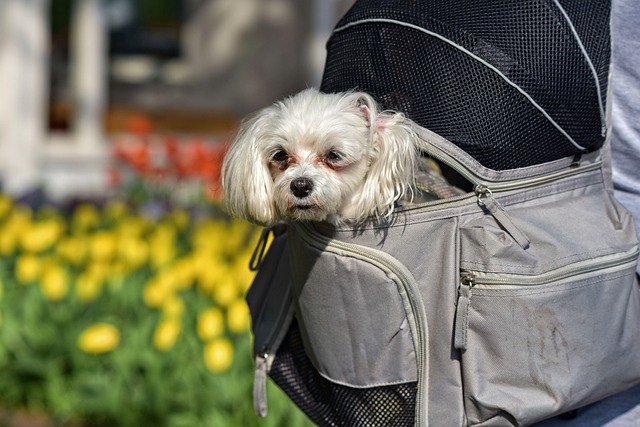
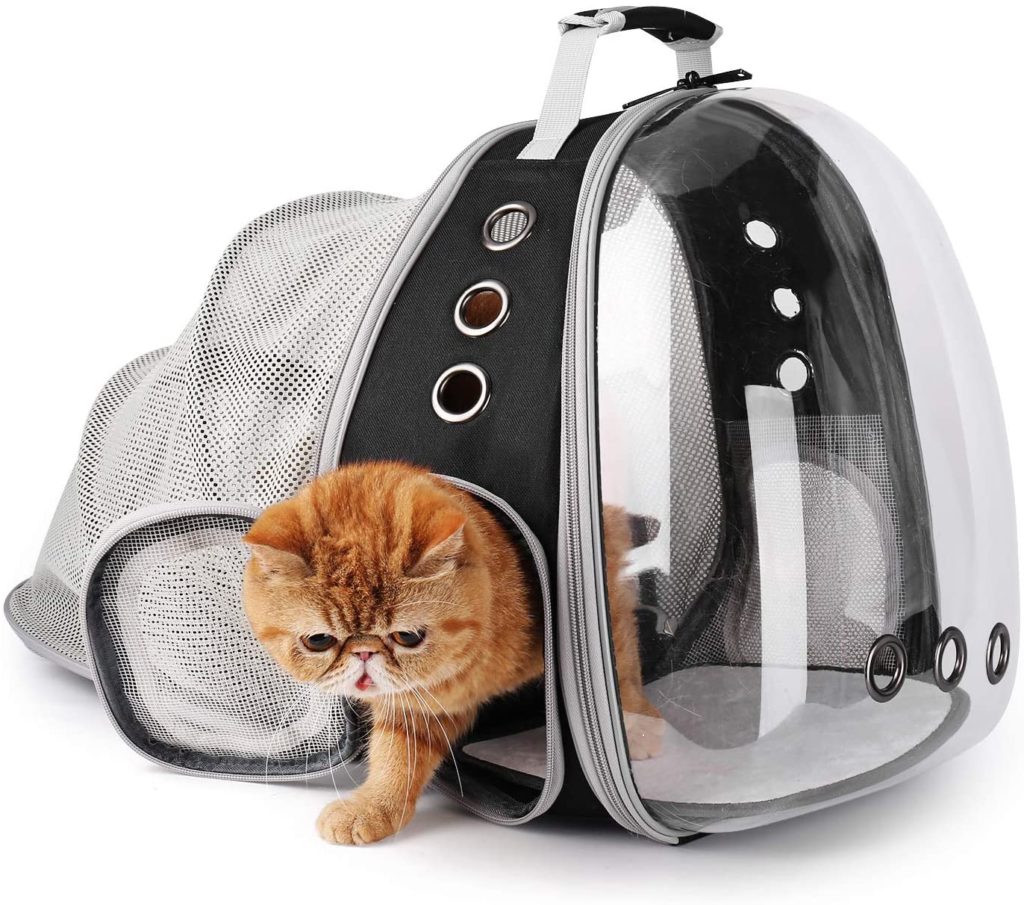
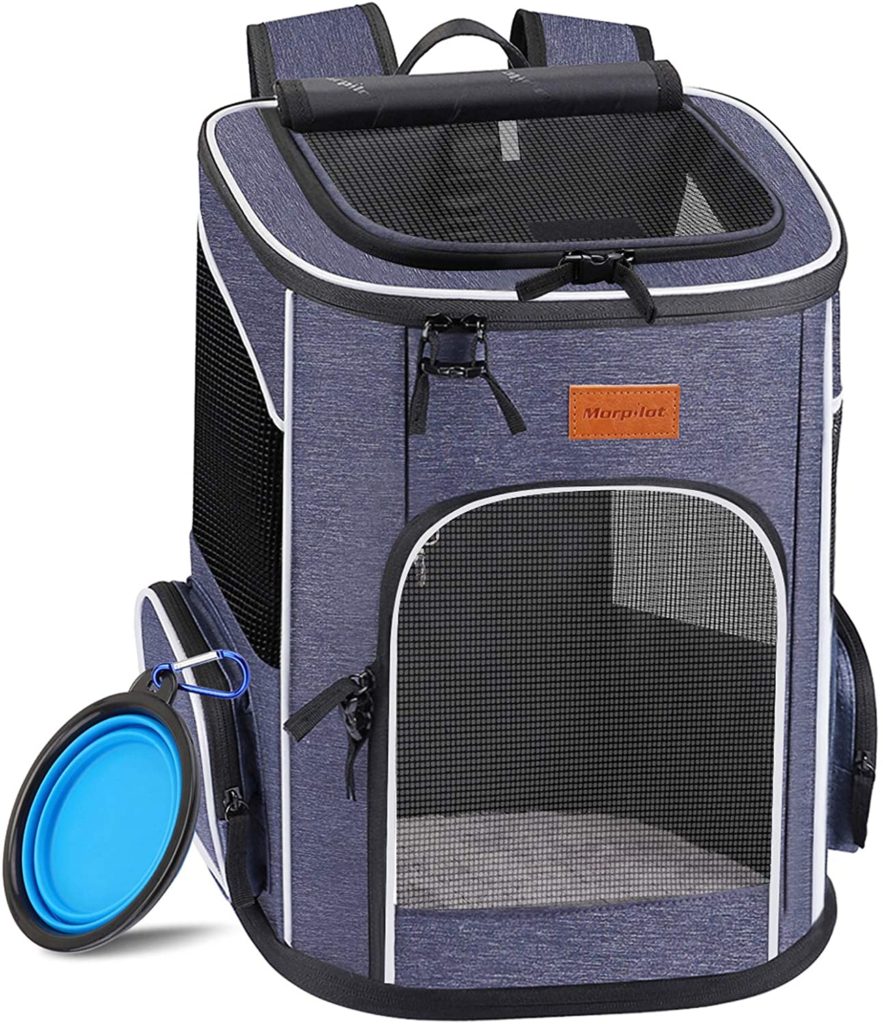
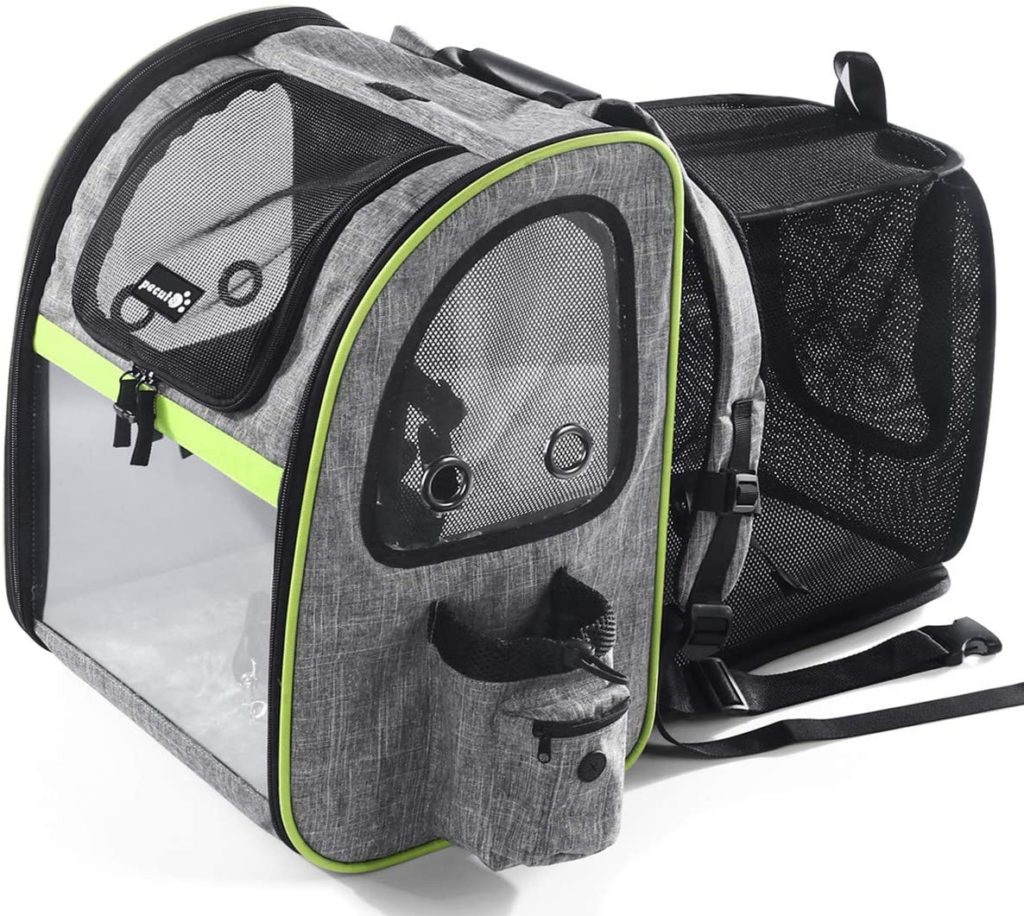
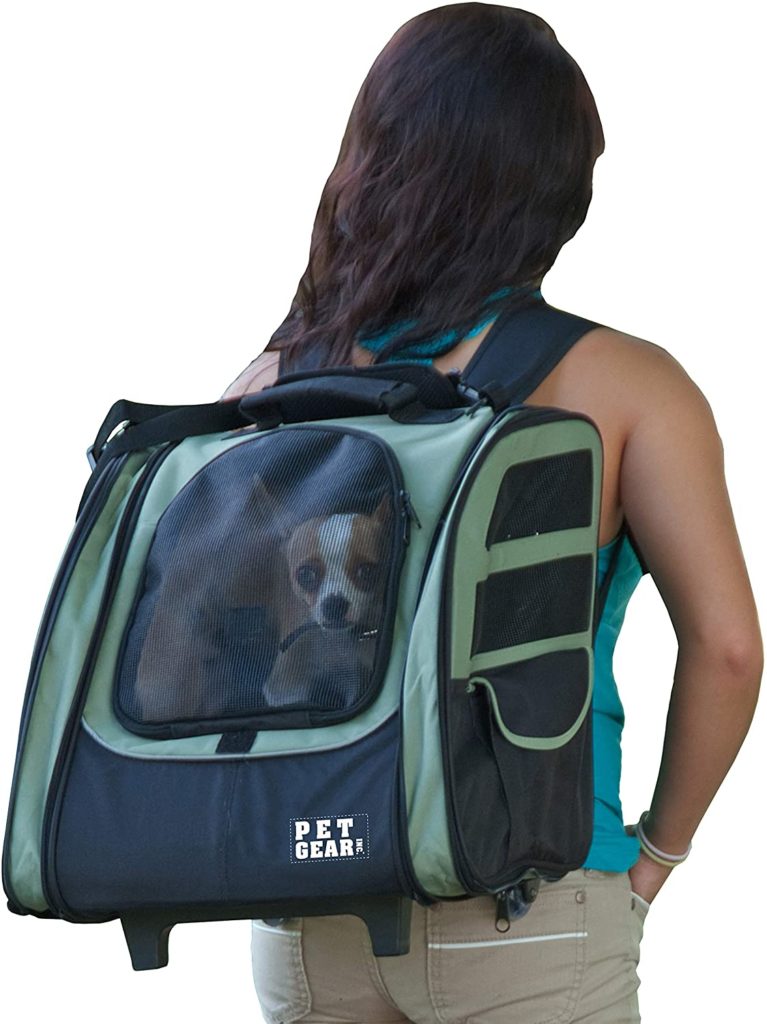
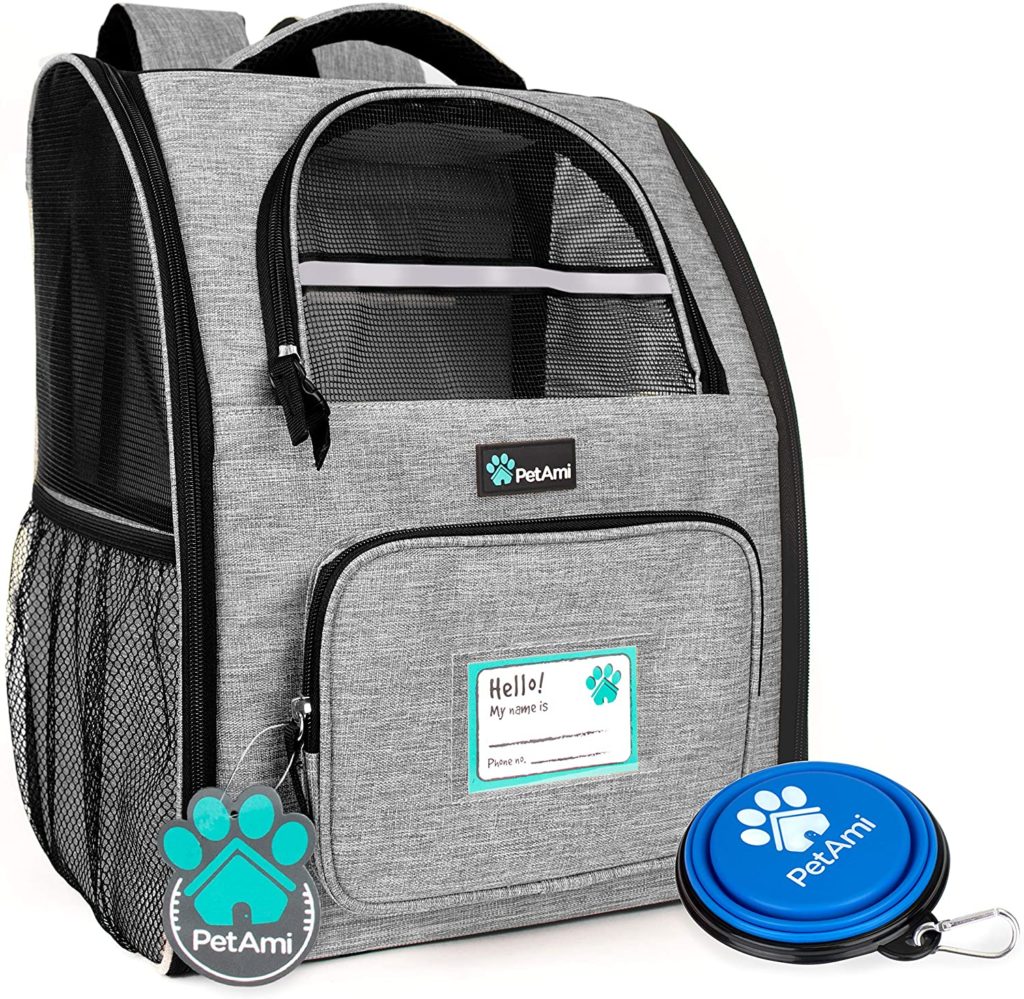
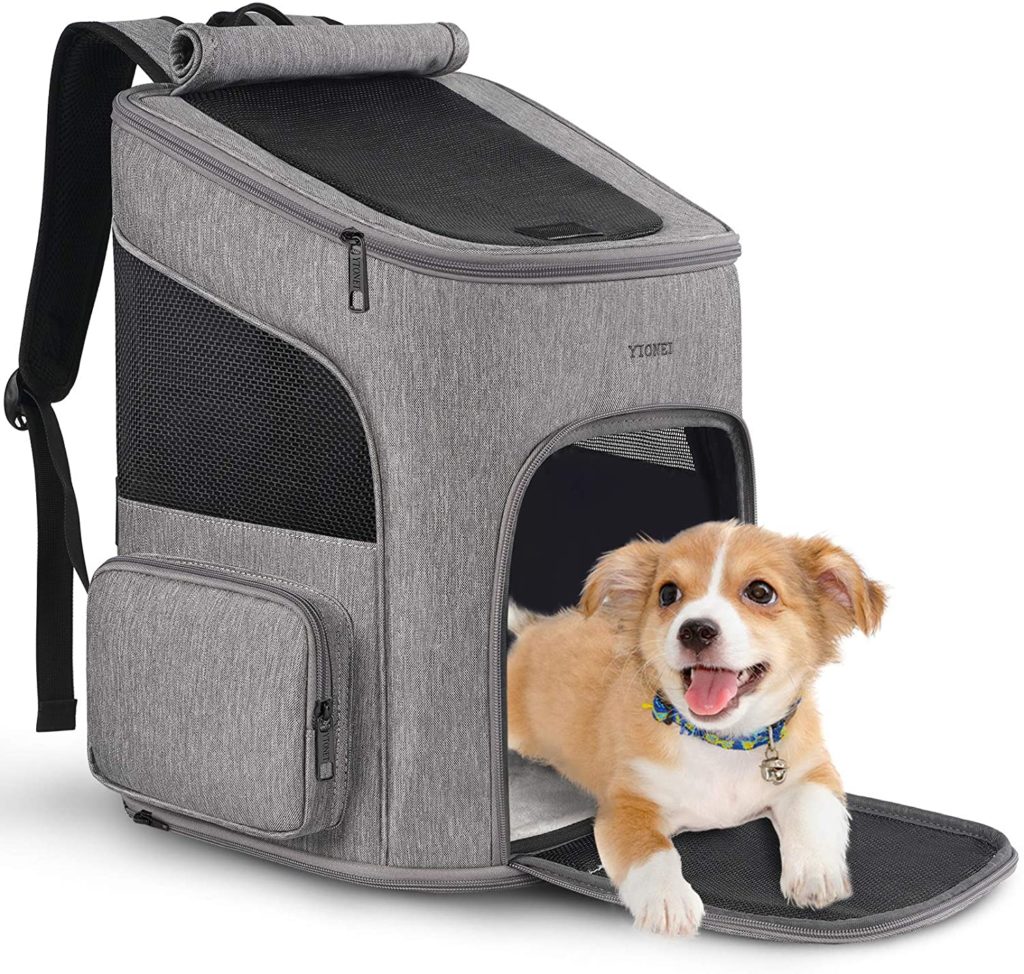
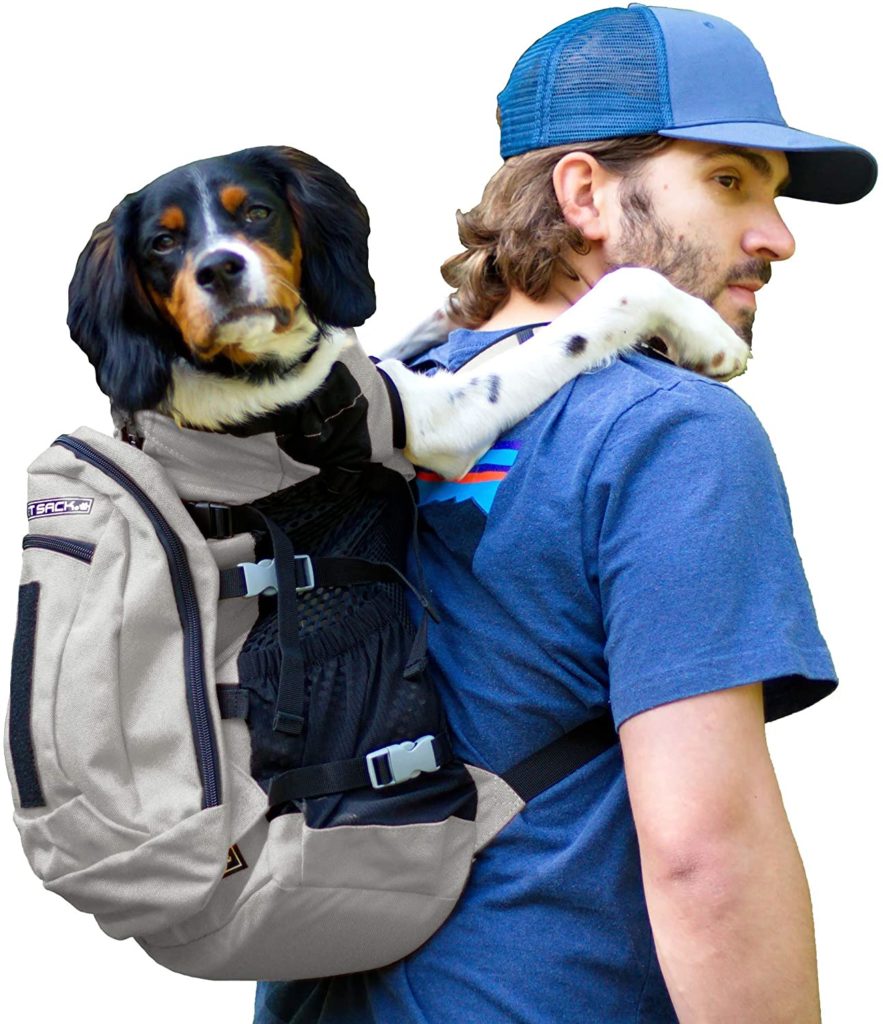
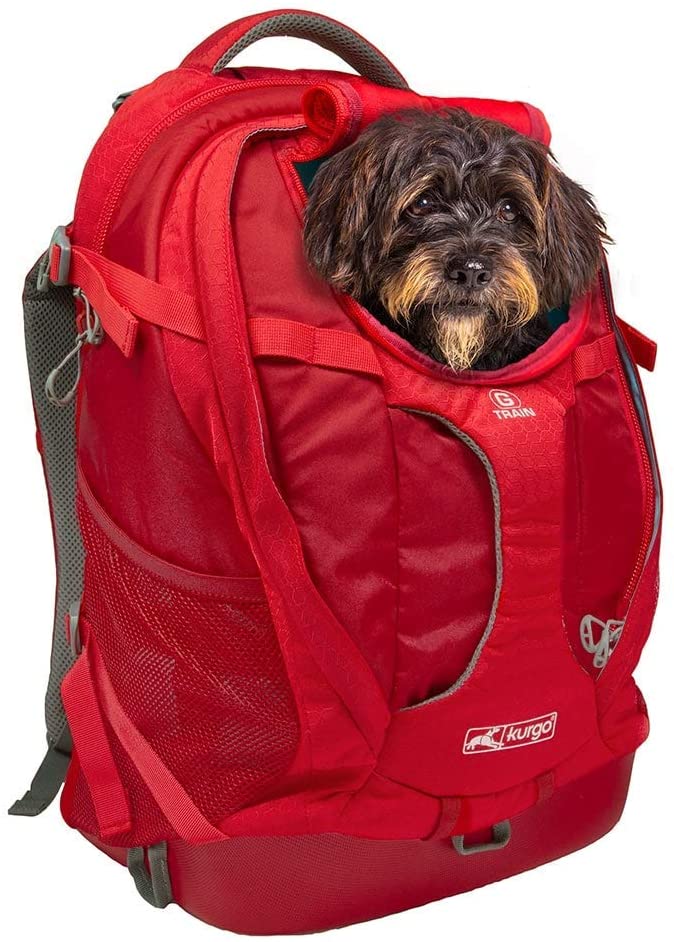
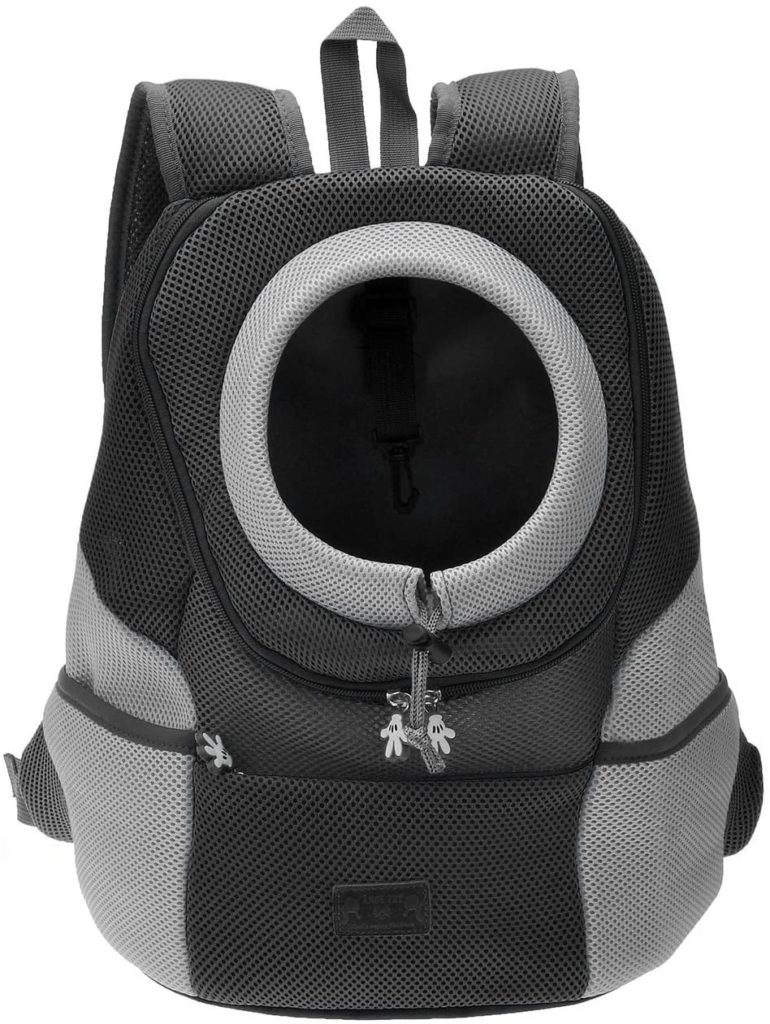
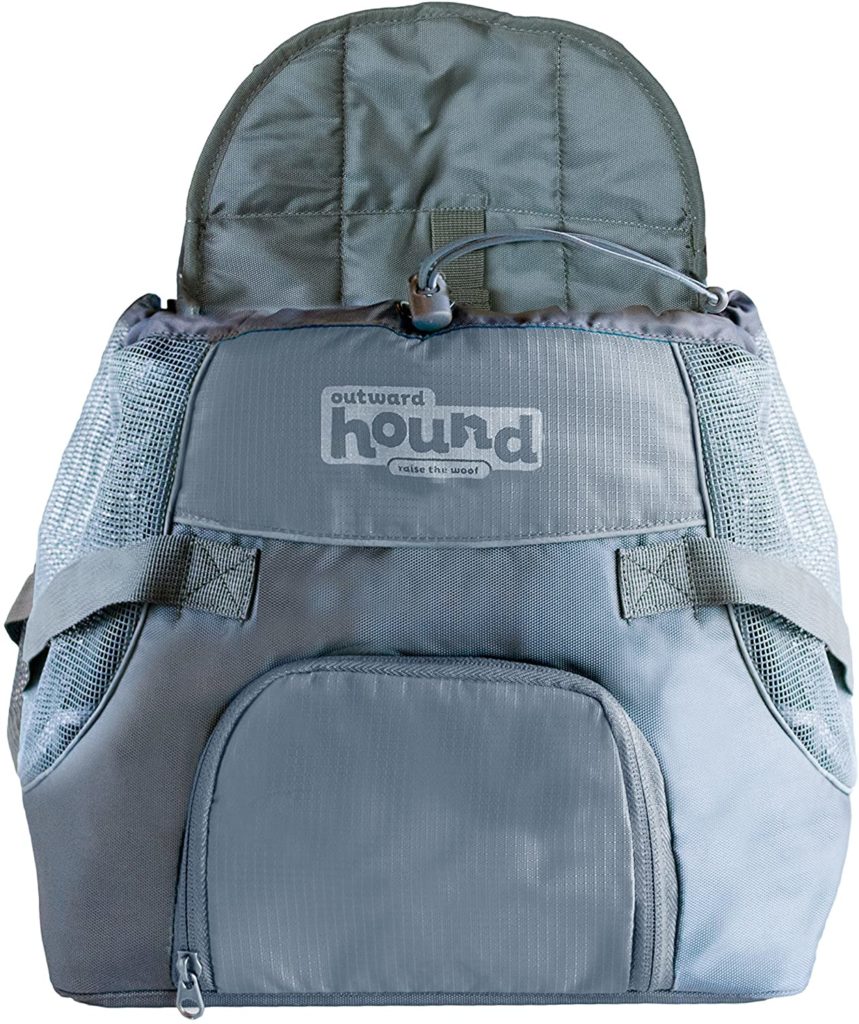
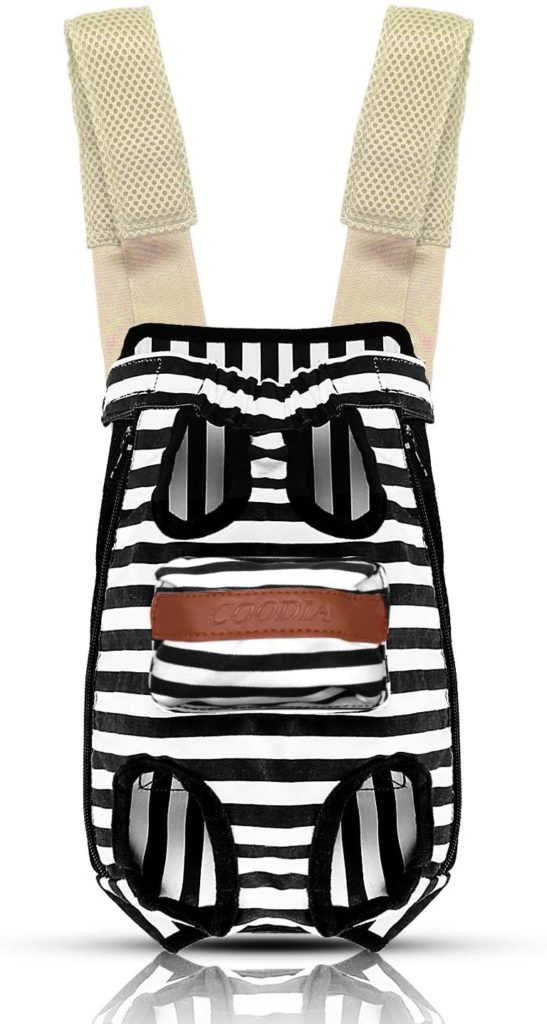
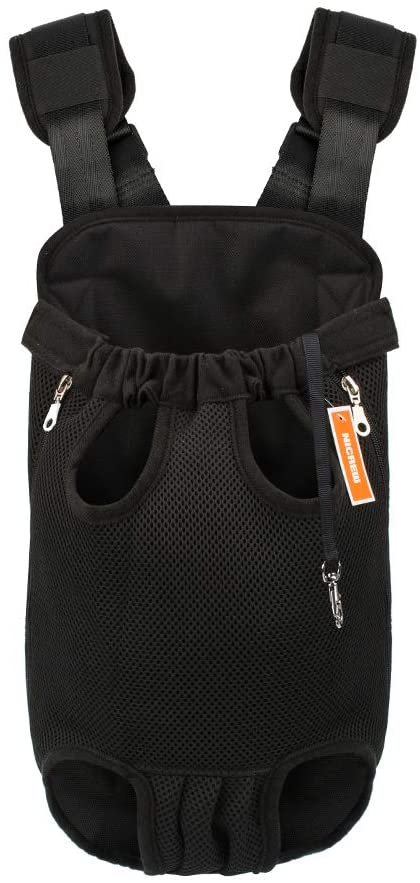
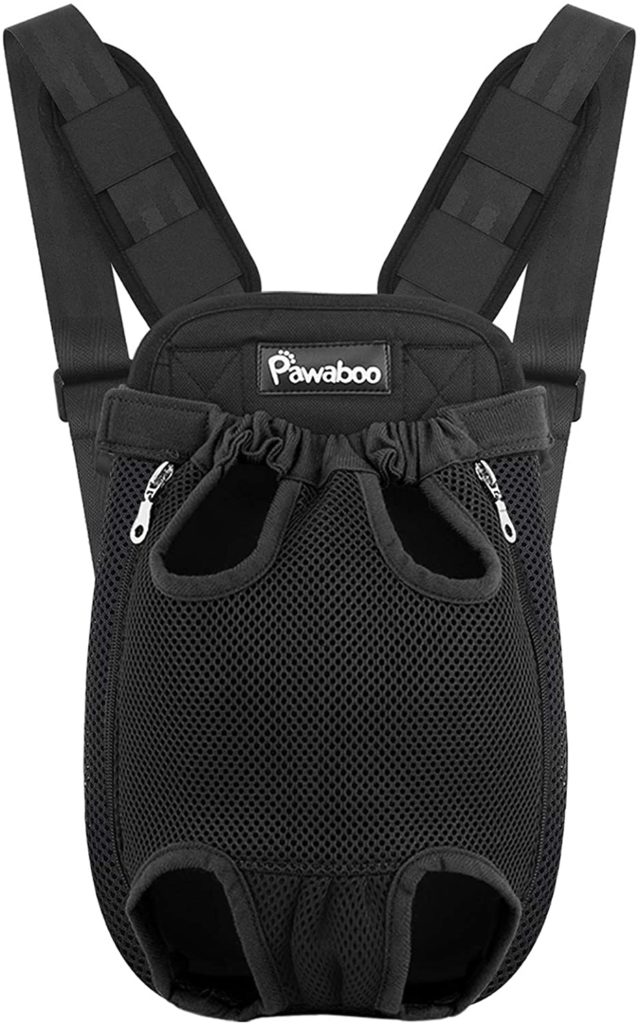
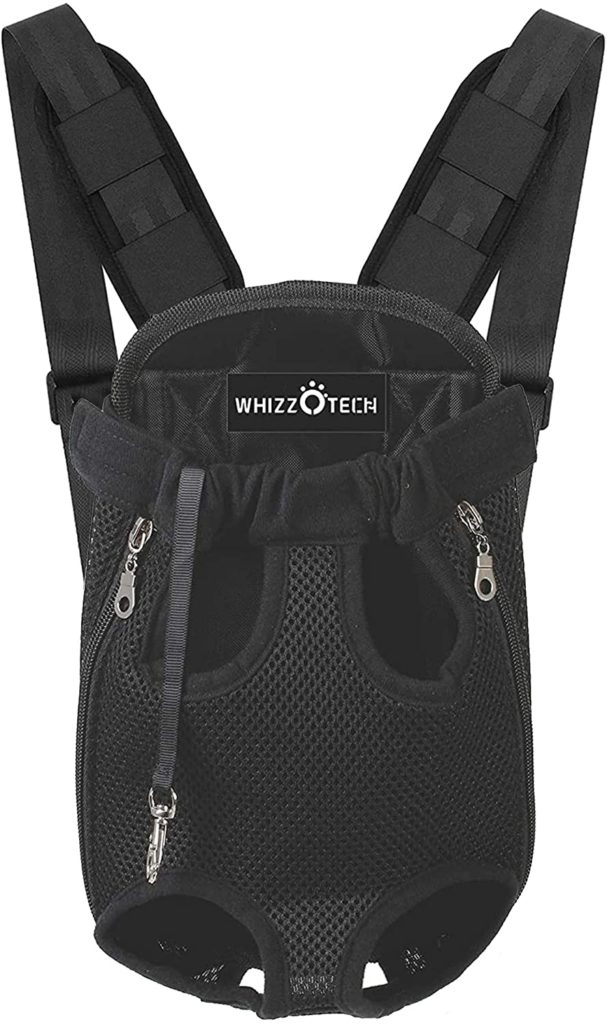




No comment yet, add your voice below!